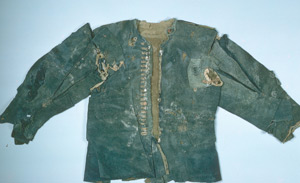The graves – silent witnesses of honoured funerals
By Kristin Prestvold
 These textiles have been amazingly well preserved for over 300 years in Svalbard due to the permafrost. Everyday clothes and textiles from 16- and 1700s are rare items and an important source of knowledge about clothing at this time. From the Smeerenburg material. (Image: Kristin Prestvold / The Governor of Svalbard) These textiles have been amazingly well preserved for over 300 years in Svalbard due to the permafrost. Everyday clothes and textiles from 16- and 1700s are rare items and an important source of knowledge about clothing at this time. From the Smeerenburg material. (Image: Kristin Prestvold / The Governor of Svalbard)
Along Svalbard's cold coastlines lie nearly 1,000 graves – silent memorials of human destinies and those who remained behind when their colleagues returned southwards, towards warmer winds. There are more graves, and they are in a larger area, than any other kind of cultural remains in Svalbard. Most of the graves date from the whaling era in the late 1600s and early 1700s. Death was a frequent visitor.
Some of the graves have been the subject of scientific archaeological examinations. In this way we have learned more about the life of whalers and gained a greater understanding about the individual in the grave.
Grave material from Svalbard shows that each person was given an honourable funeral – on dry land. Funerals at sea were avoided when they could be, and in most cases people were buried in what had with time become “cemeteries”.
The dead were laid to rest in coffins, often on a layer of sawdust. The coffins were plain, but made with good materials and often lined with a thin fabric. The dead were fully clad when buried, and they were sometimes covered with a woollen blanket. In some graves pillows filled with feathers have been found under the deceased’s head, and in several coffins moss from the deceased’s homeland has been found scattered around the body. It was as if the dead were to be kept warm and comfortable in a world that was otherwise cold and uninviting.
The coffins were buried as deeply as the permafrost would allow. Stones were placed on top of each coffin to make a small cairn. It was common to place a wooden cross at the head of the grave, as a memorial on which the deceased’s name, home and year were engraved. The solitary graves and the large grave areas are both of great value today, as they are memorials of a time that is long gone – silent witnesses of men that are buried surrounded by magnificent scenery. The deceased were treated with respect when they were interred. We should do the same today. Tread cautiously. Let the dead rest in peace.
|